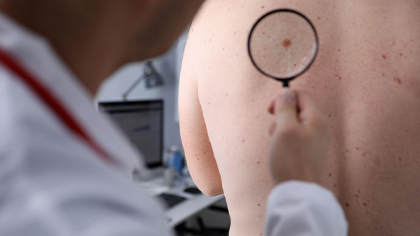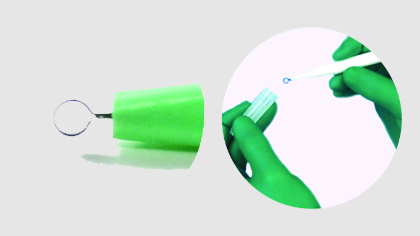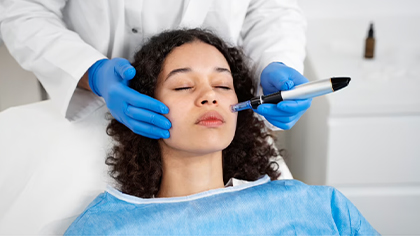An Introduction to Dermal Curette's
A dermal curette is a single-ended medical device that is primarily used to scrape skin
lesions and remove basal cell carcinomas. It has a blunt, round-ended tip on the outside
and a scalpel-sharp point on the inside. It occupies a prominent position among
dermatological, diagnostic, and therapeutic devices.
It is one of the most adaptable instruments available. As a result, it’s becoming
more widely employed in other fields, such as plastic surgery and gynaecology.
It’s razor-sharp, allowing for precise and gentle tissue removal. It’s also
effective for treating superficial malignant tumours. When compared to traditional
items, the superior cutting ability makes dealing with it much easier.
Dermal Curette Use:
A Dermal curette’s goal is to remove superficial skin abnormalities with minimal
injury to underlying tissue. The basic goal of this tool is to remove superficial skin
development without injuring the surrounding tissue. These curettes offer superior
cutting capabilities, giving them a superior alternative to traditional curettes.
Features:
In dermatology, curettes are a versatile and vital diagnostic tool.
A dermal curette’s qualities make it perfect for usage in various fields like
obstetrics, plastic and cosmetic surgery, and so on.
Because of the exceptionally sharp inner edge of the dermal curette, tissue removal can
be done both gently and precisely.
These tools can also be used to treat superficial malignant tumours.
Advantages:
Outstanding quality – The stainless-steel cutting edge is single-sided and
extremely sharp, allowing for optimal curettage in soft or weak tissue.
For more information contact your sales representative or contact us directly at
sales@ssmedico.com.
What Is Earwax Buildup?
While it might seem like a nuisance, earwax serves an important function in protecting
your ears. It’s actually a waxy oil called cerumen that’s produced inside
the ear canal. It helps keep dust, microorganisms, foreign particles, and even water
from entering and irritating your ears. The cerumen eventually makes its way out of the
ears so it can be washed away.
In some cases, your ears may produce too much wax. That excess wax can harden and cause a
blockage that can affect your hearing. Blockages are sometimes caused by using cotton
swabs to clean the ear canal because the swabs actually wind up pushing the wax in
deeper. Individuals who use hearing aids or earbuds could have an
issue with wax buildup and blockages, too.
Earwax buildup symptoms
If you’re experiencing earwax buildup or blockages, you might notice some key
symptoms, including the following:
- Full feeling in the ear
- Earache
- Sudden hearing loss
- Partial hearing loss
- Ringing in the ear
Excess earwax can also lead to an ear infection, so it’s important to see your
doctor if you develop any of the following:
- Intense ear pain
- Constant ear pain
- Fluid coming from the ear
- Odor in the ear
- Persistent hearing loss
- Fever
- Cough
- Dizziness
Curettes are a helpful cerumen management tool for audiology and medical clinics. These
tools come in many different styles and materials. There are so many options that they
can be misunderstood. Curettes are shaped like a pen and have a handle and a tip. The
tip is often a loop, scoop, or pick. Curettes are made of stainless steel, plastic, or
carbon fibre. No curette material is superior to any other and material selection really
depends on personal preference and access to hygienic reprocessing equipment. Curettes
have many advantages, they are:
- highly effective
- quick to use
- low cost
- easy to clean or dispose of
- portable
- less intimidating than other tools
SS Medical Products offers a wide range of ear curette tools at incredibly affordable
prices. Contact your representative today, or email us at sales@ssmedico.com
Biopsy Punch Application and Procedure
A punch biopsy is a procedure used to obtain a tissue sample from the body.
Punch biopsies are often used to diagnose skin cancer. A small sample of
skin is taken and then analyzed under a microscope in a lab. Punch biopsies may also
be used to diagnose cervical cancer, vulvar cancer, or conditions that
could lead to cancer.3
In this blog we describe what to expect during a punch biopsy, as well as the risks
and recovery process.
Definition
A punch biopsy is a procedure that uses a sharp, hollow instrument to remove a tissue
sample. The size of the sample is about the same as a pencil eraser and is examined
under a microscope by a pathologist in a lab. The sample can then be used
to diagnose certain types of cancer.
Process
A punch biopsy is performed in an outpatient clinic and takes about 15
minutes.4
For this in-office procedure, your healthcare provider will start by cleaning the
area of the skin with an alcohol wipe or disinfectant product. They will then inject
a local anesthetic into the skin to numb the area for the biopsy.
To take a punch biopsy, your healthcare provider will insert the hollow, circular
scalpel into the skin and gently rotate it clockwise and counterclockwise to cut
down to the layer of fatty tissue beneath the skin. A punch biopsy usually cuts
about 4 millimeters into the skin.3
Once the tissue sample is removed, your healthcare provider may place stitches to
prevent bleeding. This will depend on how deep the biopsy site is and how much it is
bleeding. They will let you know when to expect results and how to follow
up.
Diagnosing Skin Cancer
Who Does It?
Most skin biopsies are performed by a dermatologist. For a cervical biopsy,
your gynecologist will likely handle the procedure. Other healthcare
providers who are able to diagnose conditions, such as physician's assistants and
nurse practitioners, may also perform a punch biopsy.
Types of Skin Biopsies
In addition to a punch biopsy, other common skin biopsy options include:
Shave biopsy: Top layers of skin are shaved off with a scalpel.
Local excision: The skin sample is removed with a scalpel.
Mohs surgery: Thin layers of skin are removed by a surgeon and then examined under a microscope during the procedure.
Curettage and electrodesiccation: The skin sample is scraped off with a tool called a curette, then an electric needle called an electrode kills any remaining cancer cells.
Choosing the Right Biopsy for a Skin Cancer Type
Uses
A punch biopsy is used to diagnose rashes, and conditions in the skin that go deeper
than the epidermis. A punch biopsy is also used to diagnose benign growths,
inflammatory lesions, skin conditions (eczema and psoriasis), and certain types of
skin cancer (melanoma).5
How to Prepare
To prepare for a punch biopsy, sit down and talk with your healthcare provider about
what to expect. Ask questions and take notes to help you remember the details.
Be sure that your practitioner has a current list of your medications and allergies.
Let them know if you have a bleeding disorder or are taking any blood-thinning
medications as this could result in a dangerous amount of bleeding after the
biopsy.
To prepare for a cervical punch biopsy, refrain from sex and the use of tampons or
vaginal creams for 24 hours before the procedure.6
Eligibility
Your healthcare provider will discuss your eligibility for a punch biopsy with you
based on your physical exam findings and overall health. A punch biopsy is usually
recommended when cancer is suspected. If you have a bleeding disorder, your
healthcare provider will work with you to determine if a punch biopsy is safe for
you.
Outcomes/Recovery
After a punch biopsy, your healthcare provider will explain how your tissue sample
will be tested and when to expect results.
Once the biopsy is complete, your practitioner will cover the area with a bandage and
give you instructions on how to care for it at home. If they placed stitches, ask if
the stitches need to be removed or if they will dissolve on their own. At home, keep
your biopsy site clean, dry, and covered until it heals.
Warnings/Contraindications
Possible risks of a punch biopsy include bleeding, scarring, and infection. If
your biopsy site won’t stop bleeding or shows signs of infection, call your
healthcare provider right away. Signs of an infection include worsening pain,
swelling, redness, pus drainage, and a fever.
If you have a bleeding disorder or are currently taking blood-thinning medication, a
punch biopsy may not be safe for you.
Summary
A punch biopsy is a diagnostic procedure used to detect rashes, benign growths, and
chronic skin conditions. It may also be used to diagnose skin conditions that can
lead to cancer. During a punch biopsy, your healthcare provider will use a hollow,
circular scalpel to remove a tissue sample. The sample is then examined under a
microscope in a lab to look for signs of cancer.
Contact SS Medical Products today for a wide arrange of high quality Biopsy Punches.
Call your sales representative or contact us directly at sales@ssmedico.com.
Skin Stapler: Its Features and Advantages
Skin stapler is a sterile single patient use, mechanical instrument designed to
deliver precise rectangular shape stainless steel staple for routine wound closure, it
is typically used at end of surgical procedure. It has 35 pins which are Medical
grade 316L Stainless steel and forms precise rectangular shape staple
formation. The Skin Stapler has wider crown length and increased leg length
which gives outstanding performance across wider skin wounds.
It is used for skin closing in the operating room and emergency room. With this device,
the operator can shorten the suturing time. Whenever the handle is squeezed the staple
is placed one by one. The staple penetrates the skin first and then formed. Because it
is disposable, the user just peels out the package to use and should not reuse it.
- Autoclavable handle
- Improves patient safety by considerably reducing surgery and anesthesia time
- Angled tip design helps you maintain a clear view of the incision line at all times
- Lightweight but durable with a comfortable ergonomic grip design
- Simple to use — simple to reload
- Designed to reduce problems with rotated staples
Skin Stapler Design:
The handle design is characterized by good texture for a user-friendly experience. It has
a larger diameter wire, greater width, and extra staple height leading to secure wound
closure. Outstanding performance across wider skin wounds
Skin Stapler is USFDA approved and CE marked which gives the surety of consistent
quality and standard.
Advantages:
- It has multiple many advantages over suture for wound closure such as:
- Saves Time for wound closure
- Easy to use for nurses and doctors
- Lesser Trauma to the patients
- Easy extraction of Staple pins from patients
- Better cosmetic effect
Indication:
Skin Stapler is intended to be used a single time only. If it is used multiple times
it may lead to cross-contamination / Infection, Hence it is a single patient
disposable skin Stapler. It is typically used at the end of a surgical procedure
for routine wound closure.
For more information contact your sales representative or contact us directly at
sales@ssmedico.com.
How To Choose a Temperature Scanner For Your Small Business
The COVID-19 Pandemic has greatly impacted how many small businesses operate
day-to-day to keep their employees and customers safe and healthy. This includes taking
all measures possible to stop the spread of the virus.
As companies continue to bring workers back to the office and reopen their
doors to customers, the use of temperature scanners to detect fever levels is becoming
more and more popular amongst businesses of all sizes. How do you know which body
temperature scanner to pick for your small business? We put together this guide to help
you decide which one will be the most appropriate for you and your company’s
needs.
Why Does Your Small Business Need a Temperature Scanner?
The Center For Disease Control & Prevention (CDC) advises that the presence of
a fever is one screening criterion for COVID-19. A person is considered to have a fever
if their temperature reads 100.4 or higher. Many workplaces have adopted screening for
fevers as a primary guideline for detecting and helping prevent the spread of COVID-19,
along with asking employees about other symptoms they may have been experiencing (cough,
shortness of breath, etc.).
A temperature scanner allows workplaces to identify those who have a fever using a
hands-free device before entering the business, giving everyone assurance and peace of
mind walking through your doors.
How Do You Pick the Best Temperature Scanner for Your Small Business?
Trying to keep your small business running during a pandemic can be very stressful.
However, buying the best temperature scanner is one essential measure you can take to
help stop the spread of the virus and keep your employees and customers
safe.
Types of Temperature Scanners
The amount of traffic you get through your business on any given day will help narrow
down what type of temperature scanner you should get. Thermal scanners have three
different modes to measure human body temperature.
- High Traffic Density Scanners: This scanner can analyze up to 4 people at one time, so it’s ideal for businesses with high traffic (schools, sporting events, amusement parks, etc.). If a fever is detected, the scanner will make a noise.
- Medium Traffic Density Scanners: These are used in places with traffic that’s not heavy but not low, like retail stores and restaurants. They do require manual operation, though they may also have automatic fever detection.
- Low Traffic Density Scanners: The perfect option for most small businesses, low traffic density scanners are ideal for those with a small amount of traffic. They can be stationary or portable and are a cost-effective, efficient option.
We recommend a low traffic density scanner, like the Infrared Facial Temperature
Scanner to small businesses because of the smaller amount of traffic they tend to
get.
In addition to the amount of traffic your business usually gets, you will want to
consider the following factors help you choose the best temperature scanner:
Other Factors to Consider When Choosing a Temperature Scanner for Your
Business
Ease of Use
As a small business owner, you have enough to worry about; a temperature scanner
shouldn’t be one of them. Using a scanner as a screening device can be stressful
to set up if you haven’t used one before.
A scanning device should be easy to set up, use, and monitor. The H3 Plus comes
with clear, simple directions that don’t require much time or effort to assemble.
In just a few quick steps, your device will be ready to mount and start using. The best
part is you can install this scanner on a stand, the wall or use the mini
version for your desktop.
Be sure to follow all the manufacturer’s instructions for setup to ensure the
device is installed correctly and accurately.
Accuracy of Temperature Scanner
A body temperature scanner in your business is essential, especially now. When choosing a
scanner for your small business, you need to make sure it’s reliable in
consistently providing accurate temperatures all of the time.
Look out for the margin of error on the device. You want a temperature scanner that
measures human body temperature in real-time with a low margin of error. The temperature
scanner should also trigger an alarm when a fever is detected.
With an error margin of ±0.2 °F, the K3 Monitor gives accurate
temperatures efficiently and effectively. In addition, this lightweight scanner is easy
to move, shuts off after sitting idle to save on power, and sounds an alarm when a high
temperature is detected.
Speed of Temperature Scanning Results
Accuracy is important when choosing a scanning device for your business. But so is the
amount of time it takes for that scanner to give results. You want to use a device that
will produce an accurate reading in only a few seconds to help ensure you can easily and
efficiently screen employees and customers as they walk in through your door.
When choosing a body temperature scanner, be sure you pick one that will give you
dependable results in the shortest amount of time.
Final Thoughts
As a small business, you need an efficient and cost-effective solution for scanning the
temperatures of anyone who walks in your door to help screen for and stop the spread of
COVID-19. For many small businesses, a wall-mounted device or stand-alone kiosk are both
ideal solutions. Both help offer a hands-free, automated process that gets employees and
customers in the door safely and offers much-needed peace of mind during a very
uncertain time.
Our mission at Skindfense is always to provide our customers with reliable,
high-quality products that help keep small businesses safe and healthy. We invite you to
look at all the body temperature scanner options we offer and reach
out for any questions.




